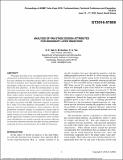Analysis of Fan Stage Design Attributes for Boundary Layer Ingestion
Author(s)
Hall, David Kenneth; Greitzer, Edward M; Tan, Choon S
DownloadV02AT37A047-GT2016-57808.pdf (3.335Mb)
PUBLISHER_POLICY
Publisher Policy
Article is made available in accordance with the publisher's policy and may be subject to US copyright law. Please refer to the publisher's site for terms of use.
Terms of use
Metadata
Show full item recordAbstract
This paper describes a new conceptual framework for threedimensional turbomachinery flow analysis and its use to assess fan stage attributes for mitigating adverse effects of inlet distortion due to boundary layer ingestion (BLI). A non-axisymmetric throughflow method has been developed to describe the fan flow field with inlet distortion. In this the turbomachinery is modeled using momentum and energy source distributions that are determined as a function of local flow conditions and a specified blade camber surface geometry. Comparison with higher-fidelity computational and experimental results shows that the method captures the principal flow redistribution and distortion transfer effects associated with BLI. Distortion response is assessed for a range of (i) rotor spanwise work profiles, (ii) rotor-stator spacings, and (iii) non-axisymmetric stator geometries. For the parameters examined, changes in axisymmetric design result in trades between rotor and stator distortions, or between different radial sections of a given blade row with marginal overall gain. Of the approaches examined, non-axisymmetric stator exit flow angle distributions were found to provide the greatest reduction in rotor flow distortion and thus may offer the most potential for mitigating decreases in performance due to BLI inlet distortion.
Date issued
2016-06Department
Massachusetts Institute of Technology. Department of Aeronautics and AstronauticsJournal
Volume 2A: Turbomachinery
Publisher
ASME International
Citation
Hall, D. K., et al. "Analysis of Fan Stage Design Attributes for Boundary Layer Ingestion." ASME, 2016, p. V02AT37A047. © 2016 by ASME.
Version: Final published version
ISBN
978-0-7918-4969-9